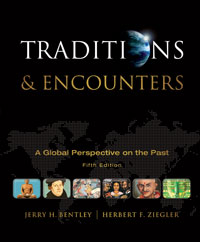1 Islam meansA) submission. B) one who has submitted. C) the god. D) Arabia. E) None of these answers is correct. 2 A) an urban-based culture with small manufacturing. B) a pastoral society with many camels. C) an agricultural society dominated by warriors. D) a society made up largely of nomads and merchants. E) a society based on maritime trade. 3 A) he was chosen by Allah to create a new religion. B) he was the last prophet of Allah. C) Judaism and Christianity were major offenses to Allah. D) Allah was one of many gods. E) None of these answers is correct. 4 A) is the holy book of Islam. B) were priests who watched over the Ka'ba. C) was Muhammad's journey to Yathrib. D) was written by Muhammad. E) were Islamic scholar-bureaucrats. 5 A) the hijra . B) the umma . C) Yathrib .D) the hajj . E) None of these answers is correct. 6 A) the hadith is to Muslims. B) the Noble Eightfold Path is to Buddhists. C) the four Vedas are to the Aryans. D) the book of Genesis is to Christians. E) None of these answers is correct. 7 sharia ?A) It offered detailed guidance on proper behavior in almost every aspect of life. B) It was created by the prophet Muhammad. C) It drew inspiration especially from the Quran. D) It drew inspiration from the hadith . E) It helped to unite the disparate parts of dar al-Islam . 8 A) The early caliphs quickly rejected many of Muhammad's teachings. B) The caliph was strictly a political leader, not a religious one. C) The early caliphs were unanimously agreed upon by the umma . D) The early caliphs concentrated on religious doctrine, not expansion. E) None of these answers is correct. 9 A) the Shia. B) the Sunnis. C) Abu al-Abbas. D) Abu Bakr. E) None of these answers is correct. 10 A) They became more and more lax in their attitudes toward Islamic doctrine. B) They levied a special head tax called jizya on non-Muslims. C) They showed great favor to the Arab military aristocracy. D) They temporarily solved the problem of succession to the caliphate. E) They maintained their simple lifestyle even in the capital of Damascus. 11 A) were from the Shia sect. B) did not allow the Arabs to play a large role in government. C) paid more attention to administration rather than expansion of the empire. D) moved the capital to Mecca. E) All these answers are correct. 12 Ulama and qadis were important in Islamic society because theyA) developed public policies and heard cases in accordance with the Quran and the sharia . B) were learned priests in the roles of magistrates and judges. C) were effective missionaries encouraging the people's obedience and devotion to Allah. D) were part of the military arm of Islam, responsible for its expansion. E) All these answers are correct. 13 A) They invaded the Byzantine empire and seized much of Anatolia. B) They converted to Islam in the tenth century. C) They usurped the Abbasid caliphate and claimed the title of caliph for themselves. D) They were conquered by the Mongols. E) They were the true source of power of the Abbasids for about two centuries. 14 A) fine silk. B) woodblock prints. C) gunpowder and cannons. D) paper. E) All these answers are correct. 15 al-Andalus , wasA) controlled by Muslim Berber conquerors. B) not part of the Abbasid empire. C) the source of a failed invasion of France. D) the home of Ibn Rushd (Averroes). E) All these answers are correct. 16 A) They could legally inherit property and divorce husbands. B) They could engage in business ventures. C) They were equal to men before Allah, not the property of men. D) They could take up to four husbands, just as a man could take up to four wives. E) None of these answers is correct. 17 A) not specifically addressed in the Quran. B) practiced long before Muhammad was born. C) adopted from Byzantine and Sasanid societies by Muslims. D) originally practiced by upper-class women. E) All these answers are correct. 18 A) They were very effective missionaries. B) They sought an emotional and mystical union with Allah. C) They used emotional sermons and song and dance to encourage devotion. D) They tolerated observances of some non-Islamic customs. E) All these answers are correct. 19 hajj A) is one of the Five Pillars of Islam. B) helped to unite Muslims from disparate parts of the world. C) ends at the Ka'ba in Mecca. D) contributed to the spread of Islamic beliefs and values. E) All these answers are correct. 20 A) Persian literature deeply influenced Islamic literary works. B) Indian numerals had a profound influence on the development of mathematical thinking among Muslims. C) The caliphs adopted Persian ideas of kingship. D) Greek rational reasoning had a long-lasting influence on the theological development of Islam. E) None of these answers is correct.





